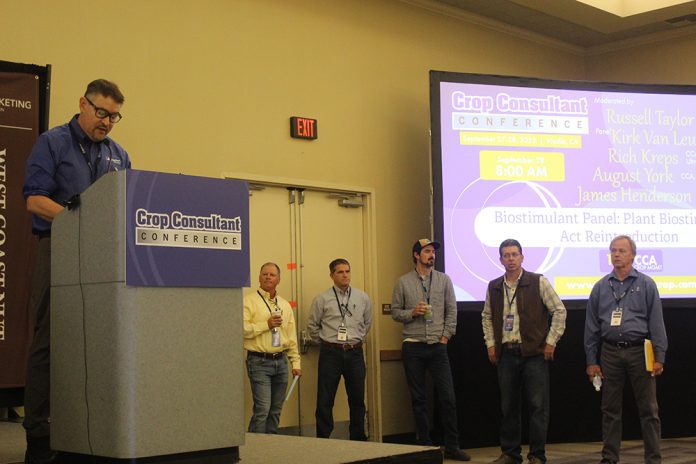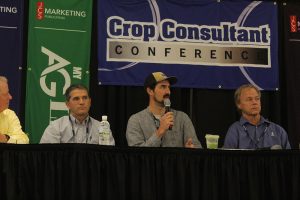
The Plant Biostimulant Act (PBA) was reintroduced earlier this year to amend the Federal Insecticide, Fungicide and Rodenticide Act (FIFRA), with the goal of providing a consistent definition for plant biostimulants. Originally introduced in the 1950s, FIFRA has been a frustrating law to navigate for an industry that has grown technologically by leaps and bounds in the 20th century.
FIFRA applies to all types of pesticides, including insecticides, herbicides, fungicides, rodenticides, antimicrobials and devices. The PBA will require the U.S. Environmental Protection Agency (EPA) to revise the existing code of federal regulations to include a new plant biostimulant definition. It will also define nutritional chemicals and require USDA to study how plant biostimulant products can contribute to soil health and several other environmental and agronomic benefits.
Russell Taylor, CCA and vice president of Live Earth Products, was the moderator at a discussion panel held on the topic at the 2023 Crop Consultant Conference in Visalia, Calif. in September. He said one of the greatest challenges ag faces with FIFRA is the law is archaic and just hasn’t updated with agriculture.
Taylor, who has also served as president of the Humic Products Trade Association for the past decade, added that, in the past, pesticides considered to be minimum risk could be exempt from FIFRA, but some of the common nutrients used in agriculture today aren’t included on the exemption list.

“Technically, some of your uses of those plant nutrients can be considered outside of FIFRA under the pesticide rule, so obviously that’s problematic,” he said.
Taylor said the law was written so poorly, that even water could be considered a pesticide under its broad criteria. He said the amendment to FIFRA will do several things to improve it like make room for biostimulants as currently only fertilizers and pesticides are outlined with no space in between. The amendment will also require the government to study the issue further, resulting in promotion and research that could be beneficial to the ag industry.
Panelists Address PBA Pros and Cons
Opening the panel discussion, Taylor said there are two elements to how fertilizers and plant biostimulants are regulated. While pesticides are regulated under the EPA, he said there is no federal agency that regulates fertilizers at the federal level, so it is left up to the states.
There is a model that has come out in recent years that states can use, however. Written by the Association of American Feed Control Officials (AFCO), the Beneficial Substance Model Bill, which is a model that every state can use, Taylor explained, essentially outlines how all the products that are not pesticides are handled.
Taylor read a statement to the audience from CDFA that stated it will soon be submitting a legislative proposal to formally include plant biostimulants into law. He said it would be a slow turn for states to adopt the rules, but at the end, all 50 states will be able to take charge to make changes that will be impactful.

Posing his first question to panelists, Taylor asked how relevant those upcoming changes by CDFA will be to California farmers and if they thought the changes were positive.
Calling California ag products some of the best quality anywhere, Kirk Van Leuven, CCA/PCA, Stoller USA, said he sees the advantage in the state’s fruit and vegetable return on farmgate.
“Where I see the big advantage to these changes for biostimulants is in the quality you get with the end product because you’re able to affect every physiological stage all the way through the growing process,” he said.
Van Leuven noted crop stress is one of the biggest things that will be able to be addressed through the new language in the amendment, and having biostimulants available during stressful stages of flowering and fruit setting will be beneficial.
“The biostimulant products, from my experience, are giving you new tools beyond what you have with just fertilizers in order to improve the crop at those stages,” he said.
Regarding product labeling, Taylor asked panelists if they would support law changes that help issues like nutrient retention and stress management, and asked if they thought those labels and products are helping innovation or not.
August York, a CCA with Intuit Ag Consulting, said he sees an inconsistency in the way products are taxed, noting something designated a fertilizer or bulk agricultural mineral is exempt from sales tax while auxiliary plant and some other stimulants aren’t exempt. He said there’s an incentive there for formulators to label as a bulk agricultural mineral.

“I think that’s an unfortunate misalignment that’s going to continue to occur as long as that tax incentive structure persists,” York said. “So, from a labeling standpoint, I feel like it is limiting, and why, as a formulator, would you ever put yourself at that disadvantage, and yet, you’re kind of forced to.”
James Henderson, CCA and president of Prime Dirt, Inc., believes growers need to have all the options they can get and said those options are becoming less and less on the chemistry side, especially.
“For example, if you grow citrus right now, you had to spray three to four or as many as six times this year for thrips because the products didn’t work,” he said. “A heavy-handed regulatory body that’s going to say that you cannot have this product or that product, to me, is not a great road to go down.”
But Henderson said he also understands the other side of it.
“I get it, as a producer and a consumer myself, you want to know, there’s a lot of white noise out there,” he said. “You want to know what’s real and what’s not real.”
Panelists also discussed soil health and how biostimulants could help with nitrogen loss.
Van Leuven said biostimulants give you the ability to manage stress in several ways, which is beneficial to the soil.
“When a plant’s working efficiently, those photosynthates go all the way down, they go out the roots, they go into the biome, they feed everything there, and an efficiently working plant that is less stressed has the ability to actually regenerate the soil,” he said.
During an audience Q&A, agricultural research scientist and small farm owner Lorianne Fought said the economic standpoint is the driving force behind using a product, regardless of how large or small an operation is. “If this product provides more benefit to my commodity than it costs, then I’ll use it,” she said.
But she said she also needs to know before she ventures into using a product how well it’s going to work. Speaking as both a scientist and a grower, Fought said she wants to see independent data beyond the manufacturer that will show what the benefit is, especially under different environmental circumstances, since she farms on hard, difficult-to-grow-on ground.
“We need to see the information, and I need to see that it’s going to provide a benefit beyond the input cost,” she said.

Kristin Platts | Digital Content Editor and Social Correspondence
Kristin Platts is a multimedia journalist and digital content writer with a B.A. in Creative Media from California State University, Stanislaus. She produces stories on California agriculture through video, podcasts, and digital articles, and provides in-depth reporting on tree nuts, pest management, and crop production for West Coast Nut magazine. Based in Modesto, California, Kristin is passionate about sharing field-driven insights and connecting growers with trusted information.















